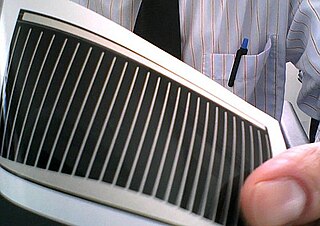
Photovoltaics (PV) is the conversion of light into electricity using semiconducting materials that exhibit the photovoltaic effect, a phenomenon studied in physics, photochemistry, and electrochemistry. The photovoltaic effect is commercially used for electricity generation and as photosensors.

A solar panel is a device that converts sunlight into electricity by using photovoltaic (PV) cells. PV cells are made of materials that produce excited electrons when exposed to light. The electrons flow through a circuit and produce direct current (DC) electricity, which can be used to power various devices or be stored in batteries. Solar panels are also known as solar cell panels, solar electric panels, or PV modules.
Konarka Technologies, Inc. was a solar energy company based in Lowell, Massachusetts, founded in 2001 as a spin-off from University of Massachusetts Lowell. In late May 2012, the company filed for Chapter 7 bankruptcy protection and laid off its approximately 80-member staff. The company’s operations have ceased and a trustee is tasked with liquidating the company’s assets for the benefit of creditors.

First Solar, Inc. is an American manufacturer of solar panels, and a provider of utility-scale PV power plants and supporting services that include finance, construction, maintenance and end-of-life panel recycling. First Solar uses rigid thin-film modules for its solar panels, and produces CdTe panels using cadmium telluride (CdTe) as a semiconductor. The company was founded in 1990 by inventor Harold McMaster as Solar Cells, Inc. and the Florida Corporation in 1993 with JD Polk. In 1999 it was purchased by True North Partners, LLC, who rebranded it as First Solar, Inc.
Sharp Solar, a subsidiary of Sharp Electronics, is a solar energy products company owned by Sharp Corporation and based in Osaka, Japan.
HelioVolt Corporation was a privately held solar energy company based in Austin, Texas that suspended operations in 2014. The company manufactured photovoltaic (PV) solar modules using a thin film semiconductor process based on copper indium gallium selenide (CIGS) to produce CIGS solar cells. HelioVolt manufactured these thin film modules for commercial rooftop, utility-scale ground mount, residential, building-integrated photovoltaics (BIPV) and custom installations. The company raised over $230 million in investments, including over $80 million by SK Group.
MiaSolé is an American solar energy company selling copper indium gallium selenide (CIGS) thin-film photovoltaic products. MiaSolé's manufacturing process lays CIGS on a flexible stainless steel substrate. MiaSolé produces all layers of photovoltaic material in a continuous sputtering process.
Global Solar Energy is a US-based manufacturer of CIGS solar cells, a thin-film based photovoltaic technology, with manufacturing operations in Tucson, Arizona, United States, and Berlin, Germany. In 2013, it was bought by Chinese renewable energy company Hanergy.
TEL Solar, formerly Oerlikon Solar, is a manufacturer of production equipment for the manufacturing of thin-film silicon cells, headquartered in Trübbach, Switzerland, near the border to Liechtenstein. The Japanese electronics and semiconductor company Tokyo Electron acquired the company of about 650 employees from OC Oerlikon in November 2012.

Ascent Solar Technologies, Inc. is a publicly traded photovoltaic (PV) company located in Thornton, Colorado. Its primary product is a flexible CIGS solar cell on a plastic substrate.

Cadmium telluride (CdTe) photovoltaics is a photovoltaic (PV) technology based on the use of cadmium telluride in a thin semiconductor layer designed to absorb and convert sunlight into electricity. Cadmium telluride PV is the only thin film technology with lower costs than conventional solar cells made of crystalline silicon in multi-kilowatt systems.

Thin-film solar cells are made by depositing one or more thin layers of photovoltaic material onto a substrate, such as glass, plastic or metal. Thin-film solar cells are typically a few nanometers (nm) to a few microns (µm) thick–much thinner than the wafers used in conventional crystalline silicon (c-Si) based solar cells, which can be up to 200 µm thick. Thin-film solar cells are commercially used in several technologies, including cadmium telluride (CdTe), copper indium gallium diselenide (CIGS), and amorphous thin-film silicon.

Between 1992 and 2023, the worldwide usage of photovoltaics (PV) increased exponentially. During this period, it evolved from a niche market of small-scale applications to a mainstream electricity source. From 2016-2022 it has seen an annual capacity and production growth rate of around 26%- doubling approximately every three years.

A copper indium gallium selenide solar cell is a thin-film solar cell used to convert sunlight into electric power. It is manufactured by depositing a thin layer of copper indium gallium selenide solid solution on glass or plastic backing, along with electrodes on the front and back to collect current. Because the material has a high absorption coefficient and strongly absorbs sunlight, a much thinner film is required than of other semiconductor materials.

Solar Frontier Kabushiki Kaisha is a Japanese photovoltaic company that develops and manufactures thin film solar cells using CIGS technology. It is a fully owned subsidiary of Showa Shell Sekiyu and located in Minato, Tokyo, Japan. The company was founded in 2006 as Showa Shell Solar, and renamed Solar Frontier in April 2010.
Siva Power, Inc. is an American solar power company that developed thin-film technology. The company designed and manufactured copper indium gallium deselenide (CIGS) photovoltaics. Siva Power is based in San Jose, California. Bruce Sohn is CEO and Mark Heising is Chairman.
Flisom was a developer and manufacturer of photovoltaic (PV) thin film solar cells located near Zürich, Switzerland, founded in 2005. The company produced high-efficiency CIGS thin film solar modules on flexible plastic foil using proprietary roll-to-roll manufacturing techniques. It went into liquidation in 2023.
The Stion Corporation was a solar company based in the United States with headquarters in San Jose, CA and manufacturing in Hattiesburg, MS. Founded in 2006, Stion developed thin-film solar panels. The company was majority backed by Khosla Ventures. Stion also provided turn-key solar systems for end users of electricity through its vertically integrated development arm, Stion Energy Services. The company ceased operations in 2017 citing foreign competition.








